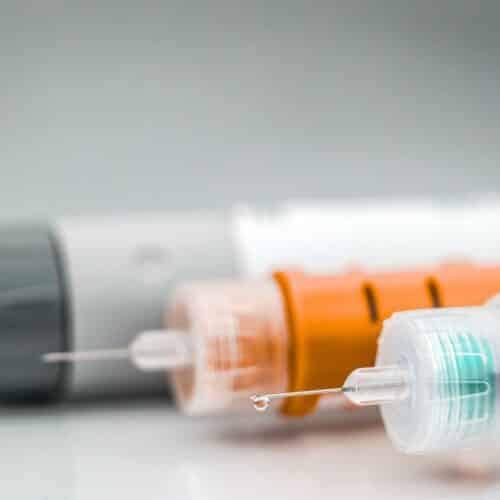Exenatide-PD3 results published

The full results of the Exenatide-PD3 study, a phase 3 clinical trial of Type 2 diabetes drug exenatide (Bydureon), have now been published. They report that the study unfortunately did not meet its primary or secondary endpoints.
The full results of the Exenatide-PD3 study have now been published in the scientific journal, The Lancet, and is publicly available.
What was Exenatide-PD3?
Exenatide-PD3 was a UK-wide, phase 3 clinical trial that evaluated whether exenatide (Bydureon) could slow the progression of Parkinson’s motor symptoms. Exenatide belongs to a class of Type 2 diabetes drugs called glucagon-like peptide 1 receptor (GLP-1R) agonists. Led by Professor Tom Foltynie at University College London (UCL) and funded by the National Institute for Health and Care Research (NIHR), this trial was made possible thanks to the commitment of 194 individuals with Parkinson’s who took either exenatide or a placebo (dummy drug) over the course of 96-weeks.
The primary endpoint of the study – the predetermined measure of success researchers set when creating a clinical trial – was whether there were changes in the progression of the participant’s motor symptoms throughout the duration of the trial. Unfortunately, the results indicate that there was no significant difference between the treatment and placebo groups (those not taking active drug), meaning there was no evidence of exenatide slowing Parkinson’s progression. There was also no difference between the groups with any of the other measures included in this trial.
Why was exenatide being tested in Parkinson’s?
Leading up to this trial, there has been strong pre-clinical and epidemiological evidence to suggest that exenatide has a protective effect in the context of Parkinson’s. There were also encouraging phase 2 clinical trial results with exenatide as well as the recent clinical success of another GLP-1R agonist, lixisenatide, in people with Parkinson’s. These compelling preliminary results have prompted questions as to why Exenatide-PD3 did not have a similar outcome.
In their paper, the researchers sought to address this by exploring several possible explanations. These include differences in the devices used to administer exenatide between the phase 2 and 3 trials (tray vs pen), a potential placebo effect, and differences in the participant populations; however, there was no strong evidence to suggest any of these factors affected the results.
One area that may warrant more investigation is brain penetrance, or how well a drug is able to enter the brain. Although the phase 2 trial demonstrated that exenatide reached the part of the brain affected by Parkinson’s, analysis of participant’s cerebrospinal fluid – the fluids surrounding our brain and spinal cord – have suggested that this is only in relatively low amounts. Moving forward, it may be worth investigating whether another GLP-1R agonist with better brain penetrance could have more impact.
What are the next steps?
Although it is disappointing that these results are negative, this does not mean there are no important learnings from the trial. These results play into the much larger story of GLP-1R agonists and Parkinson’s, which are being investigated in trials and laboratory studies across the world.
The Exenatide-PD3 research team will continue to examine the trial data in a Cure Parkinson’s funded post-hoc analysis in order to get a better understanding of what exenatide, and GLP-1R agonists more broadly, interact with in the body to achieve a protective effect. Additionally, we are still waiting on the results of another sub-study, funded by Cure Parkinson’s with Van Andel Institute (VAI), which examined whether a wearable device and smartphone app can be used to help track motor symptoms. The findings from this research could help inform and improve the ways we measure change in trials and provide a more accurate reflection of participant experiences.
Overall, one thing we can be very confident in is the validity of the Exenatide PD3 results. The trial was a double-blind, randomised, placebo-controlled study – the gold standard of clinical research – and it was conducted by a world-class team of investigators. Cure Parkinson’s and the trial coordinators are extremely grateful to all the participants and their families for volunteering to take part in the study, and we will continue to work with the research team to understand how best to move forward following these results.
Prof Foltynie presented these results at our recent Autumn Research Update Meeting. Watch the recording of this below.
Q&As
What is exenatide?
Exenatide is a once-daily injectable pen which belongs to a class of Type 2 diabetes drugs called GLP-1 receptor agonists. It is sold under the brand names Byetta or Bydureon, the latter being used for the Exenatide PD-3 study.
What are GLP-1 receptor agonists?
Glucagon-like peptide 1 receptor agonists (or GLP-1R agonists) are a class of drugs used in the treatment of Type 2 diabetes. They act by mimicking the action of a naturally produced gut hormone called GLP-1 in the body. GLP-1 is produced by cells lining the intestines when food and drink is consumed, stimulating insulin to be released by the pancreas. Insulin helps cells absorb glucose (sugar) from our food to be used as energy.
Read more about Type 2 diabetes and the connection with Parkinson’s
What was Exenatide-PD3?
Exenatide-PD3 was a UK-wide, phase 3 clinical trial that evaluated whether exenatide (Bydureon) could slow the progression of Parkinson’s motor symptoms. Led by Professor Tom Foltynie at University College London (UCL) and funded by the National Institute for Health and Care Research (NIHR), this trial involved 194 individuals with Parkinson’s taking either exenatide or a placebo (dummy drug) over the course of 96-weeks.
What were the Cure Parkinson’s and VAI funded sub-studies?
Cure Parkinson’s and Van Andel Institute (VAI) funded two sub-studies for the Exenatide-PD3 trial. The first was looking at DaTSCANs in participants at the beginning and end of the trial. DaTSCANs are a type of brain imaging test which measure levels of dopamine in the brain.
The second sub-study, led by Professor Michele Hu at Oxford University, looked at whether wearable gait (the way someone walks) monitors and a smartphone app could be used to monitor participant’s motor symptoms during the trial.
Currently, researchers use a comprehensive question assessment called the Unified Parkinson’s Disease Rating Scale (MDS-UPDRS) to measure trial participant’s symptoms, with Part 3 of the scale being focused on motor symptoms. In recent years, however, researchers have been looking for better ways to monitor symptoms, including the use of wearable technology like smartwatches, which would offer continuous data that is a better reflection of participants’ lived experiences.
The results of this sub-study are expected in the first half of 2025.
What are the different stages of clinical trials?
There are three main phases of clinical testing for a drug or compound in people. Phase 1 is a small study testing the safety of a potential treatment, usually in a group of healthy people over a short period of time. Phase 2 is a larger study assessing the safety of a potential treatment over a longer period of time, in a much larger group of people who are affected by the disease. Phase 2 studies often include measures of efficacy to get an idea of whether a treatment is doing what it is supposed to do. Phase 3 is the last stage of clinical testing and involves a very large cohort of people affected by the disease being tested for a long period of time to determine the effectiveness of the potential treatment alongside its long-term safety. Exenatide-PD3 was a phase 3 trial.
What were the results of the Exenatide-PD3 study?
Unfortunately, exenatide did not appear to have any effect on the progression of motor symptoms in people with Parkinson’s over the 96-week study. Trial data indicate there was no difference between participants taking the placebo (dummy drug) and those taking exenatide.
What will happen next?
The trial team will now work to better understand these results in a Cure Parkinson’s and Van Andel Institute funded post-hoc analysis, which we look forward to hearing the results of.
What are the other GLP-1R agonists being looked at for Parkinson’s and do they all have the same effect in Parkinson’s?
There is a wide range of subtle differences between the broader class of GLP-1R agonists and they have not all been tested in Parkinson’s. Some GLP-1R agonists significantly reduce body weight (which might add concerns of frailty for people with Parkinson’s). Some GLP-1R agonists do not cross the blood-brain-barrier very well, and therefore are not able to have an effect in the brains of people with Parkinson’s. It is important to note that more research is required to better understand these differences in the context of a potential treatment for Parkinson’s.
Of the GLP-1R agonists that have been in trial for Parkinson’s, there have been a variety of results. The phase 2 trials of lixisenatide and exenatide both met their primary outcomes, signalling that these drugs may have an effect on Parkinson’s progression. The phase 2 trial of liraglutide, another GLP-1R agonist, however, did not demonstrate this, but did show signs of helping with participant’s non-motor symptoms. The addition of the Exenatide-PD3 results demonstrates the need for researchers to further investigate this class of drugs to better understand the effects that each of them is having in the brain.



